The Apple Thunderbolt Display Review
by Anand Lal Shimpi on September 23, 2011 2:56 AM EST- Posted in
- Displays
- Mac
- Apple
- Thunderbolt
- Thunderbolt Display
Dissection
If you haven't gathered by now, the Thunderbolt Display isn't a regular monitor - it has a lot of components inside that you'd typically only find in a full fledged computer. Being the curious cat I am, I wanted to see inside. Apple isn't too fond of us poking around inside their review samples, but luckily the Crabtree Valley Mall Apple Store just got Thunderbolt Displays in so I hopped in the practical-wagon and grabbed one in the name of science.
Apple has an incredible fascination with using magnets in its designs. What it enables are some pretty neat enclosures, particularly on its displays. The glass front of the Thunderbolt Display is actually identical to what's used on the 27-inch LED Cinema Display and iMac. The glass is held to the chassis via several very strong magnets. To remove the glass you'll need to use suction cups:
Behind the glass front is the actual LCD panel itself. The LCD and backlight are enclosed in a single unit. What we're interested in is behind the LCD however. Unplug a few cables and remove a grounding screw and the LCD unit is easily cast aside. Behind it are two discrete PCBs:
The PCB on the left is the monitor's power supply. Looking at another half-wave rectifier isn't on my to-do list this time, so we turn our attention to the right PCB. This is the board that handles all of the IO on the Thunderbolt Display. All of the screws we've removed thus far just need a T9/T10 torx bit.
The Thunderbolt Display's motherboard is full of controllers driving all of the rear facing IO ports. Contrary to what we originally posted, I now believe this is the same Light Ridge controller we've seen on other Macs (not the MacBook Air):
The external Thunderbolt cable actually continues inside the display and ends up at an internal Thunderbolt port. The cable terminates at the port and then is routed via traces on the PCB to the Eagle Ridge chip:
The other controllers are sprinkled around the PCB, although there's enough space between all of them to make routing nice and easy. The beauty of designing PCBs for monitors like this is you have tons of room to work with.
Pericom provides a PCIe x1 to 4-USB-port adapter on the board:
The internal speakers are driven by a combination of an ST-NXP 0161ET USB audio controller and an Analog Devices ADAV4601 audio processor. The ST-NXP controller sits on an internal USB interface, while the ADAV4601 dangles off of it.
That wraps it up for the front of the PCB. Around back there's a collection of stereo amps as well as the GigE (Broadcom BCM57761) and FW800 (LSI L-FW643E-2) controllers.
There's nothing immediately apparent in the PCB design that would point to the cause of the issue we saw with the Promise Pegasus interfering with the Thunderbolt Display's USB audio controller. The root cause must be exclusive to the Pegasus.








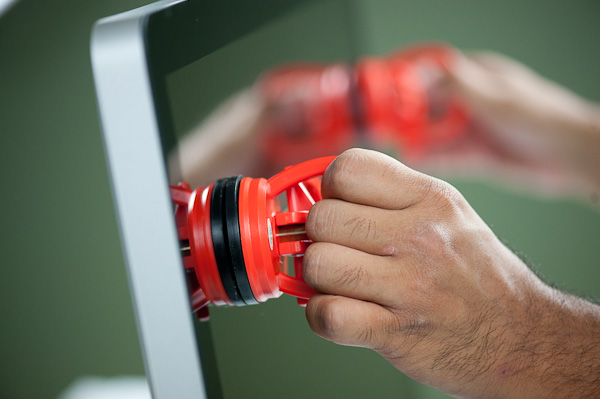
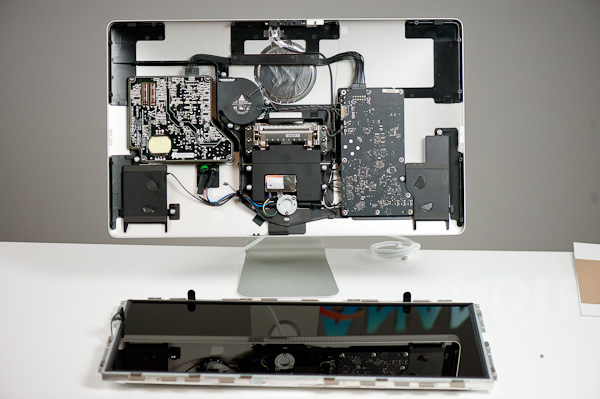
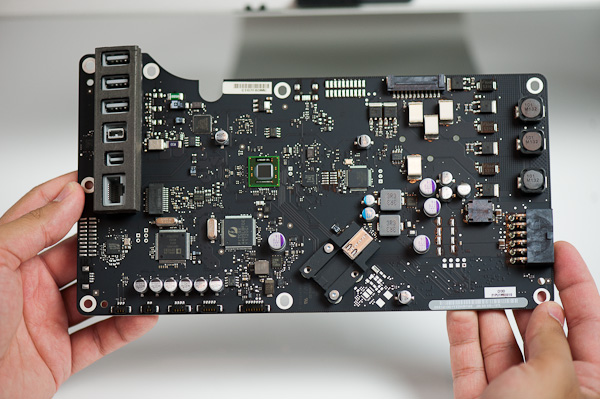
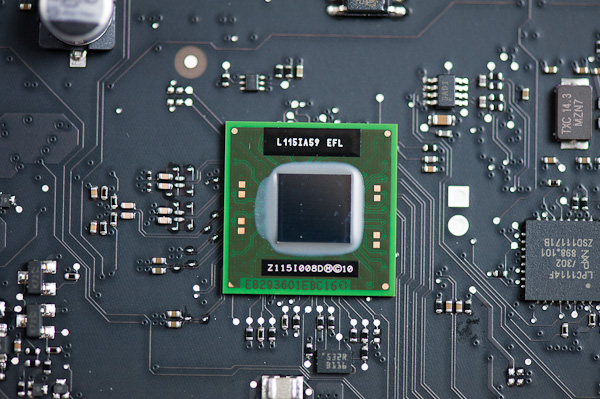
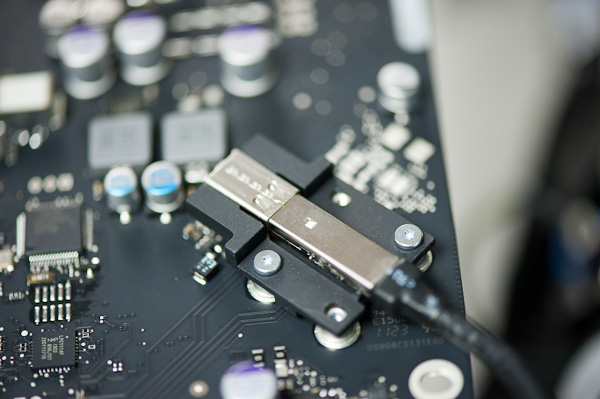
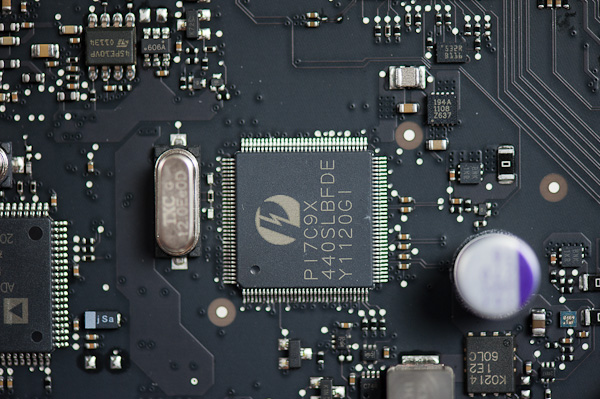
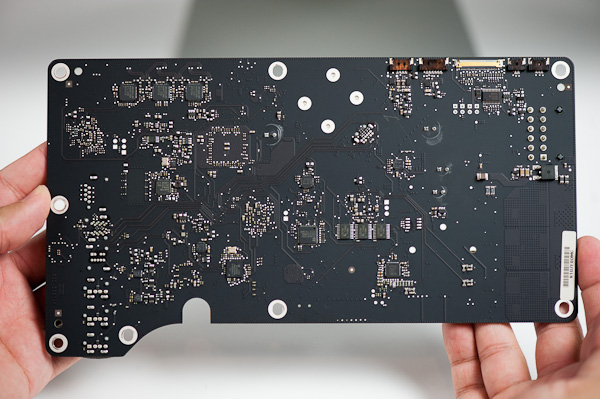
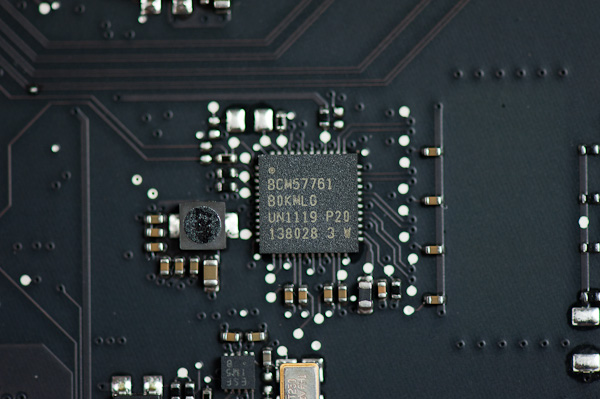








275 Comments
View All Comments
mcturkey - Friday, September 23, 2011 - link
I guess I really don't understand why they can't just make a non-integrated docking station. Use Thunderbolt to connect it if need be, but making it part of the display seems to just add a very unnecessary expense increase if you find yourself needing a new monitor or different/more/better ports in the future.Constructor - Friday, September 23, 2011 - link
As far as I'm aware there are already multiple external PCIe slot housings and other adapters on the way which will effectively serve that purpose.And all of them will be usable with any Mac or PC which has suitable PCIe drivers for the respective ports, so Thunderbolt can indeed provide the long-missing "universal dock".
The complication may be that these drivers should be able to survive hot plugging if you want to avoid having to reboot the machine every time you (dis)connect such an external box (or possibly risk a blue screen / kernel panic otherwise).
Apple just chose to make one specific bundle product; They're leaving all the other possibilities to third parties so far. Once such alternatives are on the market, it's simply your choice.
SameerRamesh - Friday, September 23, 2011 - link
My strong gut feeling suggests that apple will bring only USB 3.0 ports to all their next-gen Macs. Why?Intel's IVB chipsets have native USB 3.0 support. So apple needn't do any extra work there. Furthermore, not adopting an industry standard is a loss. Adding to that, they haven't gone against USB 3.0 now, have they?
Why only USB 3.0 in the next-gen Macs? That's Apple's style!
Constructor - Friday, September 23, 2011 - link
Current Intel chipsets don't have USB3 on chip, so it would take external USB3 controllers to add them to a Mac.The problem is that such external controllers consume precious PCIe 2 lanes which are comparatively scarce with the mobile Intel CPUs. I've not checked the data sheets, but there may simply not be enough PCIe 2 lanes with a mobile Intel CPU to supply both a full-speed-capable external USB3 controller and the Thunderbolt controller at the same time.
Given that choice, I'd say Thunderbolt is the far better option of the two (not least since you can connect USB3 externally through it, but not vice versa).
Desktop CPUs are less constrained, so the iMac and the Mac Pro could have both at the same time even with the current CPU generation (through PCIe plugin cards, if need be).
But I expect Apple to make the jump with the upcoming CPUs which simply provide them on chip with nothing to sacrifice for it.
JasperJanssen - Saturday, September 24, 2011 - link
Ivy Bridge generation Macs will obviously have USB3. Presumably enough of them so that there are no USB2 ports left, as Apple does not like mix and match. And when the Macs have USB3, the display will get it too.quiksilvr - Friday, September 23, 2011 - link
Can you use this Thunderbold Display on another Thunderbolt computer that isnt Mac?Anand Lal Shimpi - Friday, September 23, 2011 - link
Theoretically, yes. We won't know for sure until we see the PC implementations of Thunderbolt but according to Apple if a PC vendor were to integrate Thunderbolt and fully follow the spec the Thunderbolt Display would work.Take care,
Anand
the goat - Friday, September 23, 2011 - link
Somebody already solved this problem decades ago. It is called a laptop docking station. All those cables you are complaining about stay plugged into the docking station.Parhel - Friday, September 23, 2011 - link
That's what's confusing me about this too. Why is this better than, or even as good as, a docking station?With my docking station, I just have to put my laptop on it, and I'm connected to wired network, monitor, mouse and keyboard. I could add another monitor (2 dual link DVI ports), speakers, a printer, and I believe 4 USB devices to that.
I have one docking station at home, one at the office. The dock for home cost me under $100, and it's compatible with both my laptop and my wife's. This seems like a step down from that.
HMTK - Friday, September 23, 2011 - link
If you wan't a razor thin laptop like a MBA there's no room for a docking connector in the laptop. That's probably the main reasons why Apple makes this thing. For their customers it's good.Personally I prefer a docking station exactly for the reasons you stated. I would like to use a generic docking station that's not USB though because now docking stations can only be used with a limited number of machines and there's no compatibility between brands.
Laptop makers are being forced by the EU to make compatible power bricks. Why not do the same for docking stations? Or force them to make a single connector for data and power that's also compatible with a power supply only?